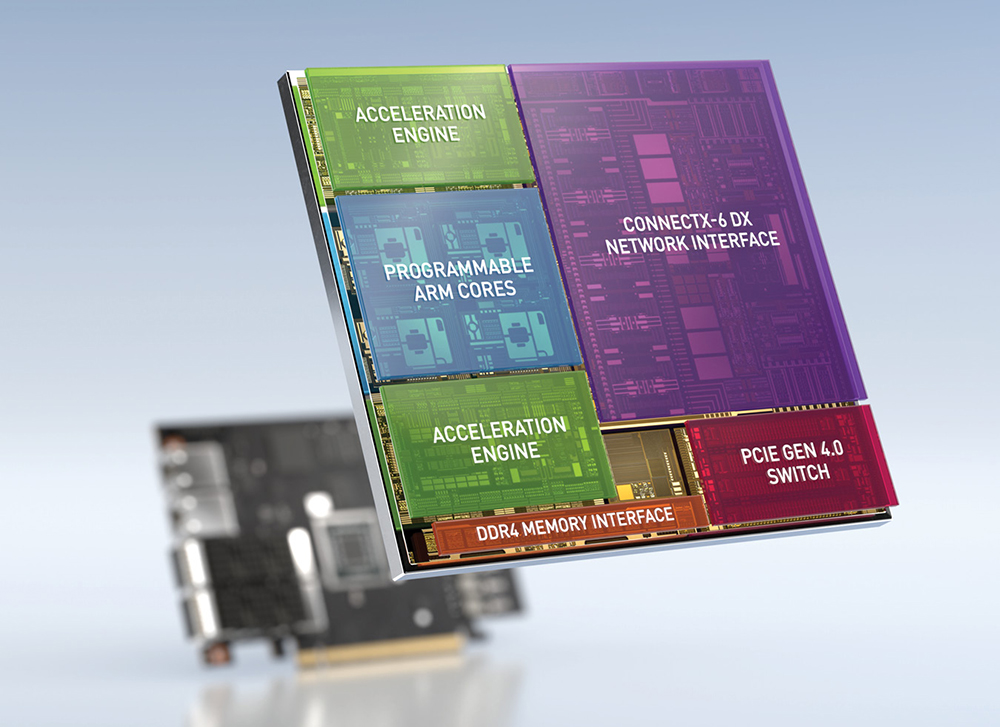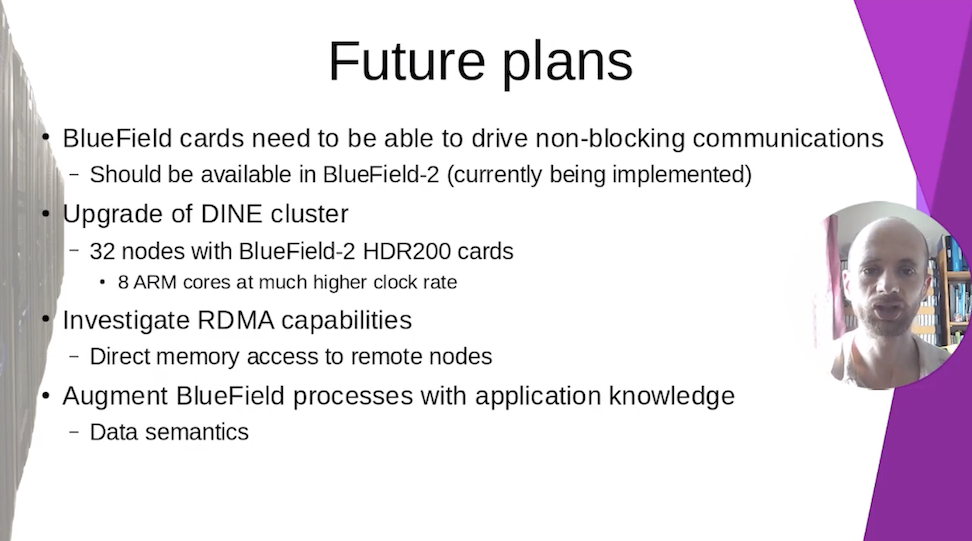In conjunction with GTC21, Dell Technologies today announced new supercomputers at universities across DiRAC (Distributed Research utilizing Advanced Computing) in the UK with plans to explore use of Nvidia BlueField DPU technology.
The University of Cambridge will expand its Cambridge Service for Data Driven Discovery (CSD3) system featuring:
- More than 400 PowerEdge C6520 servers with 3rd Gen Intel Xeon Scalable processors;
- More than 80 PowerEdge XE8525 servers with 3rd Gen AMD Epyc processors and Nvidia A100 GPUs with NVLink;
- And four petaflops of application performance to advance research across astrophysics, nuclear fusion power generation and clinical medicine applications.
Durham University’s COSMA8 supercomputer, currently in prototype, is set to fully deploy in October 2021 with:
- More than 90 PowerEdge C6525 servers with 2nd and 3rd Gen AMD Epyc processors;
- Direct Liquid Cooling and Nvidia Mellanox HDR InfiniBand networking
- And plans to expand COSMA8 to more than 600 compute nodes over the next year to deliver computational power and efficiency for research into dark energy and black holes.
(DiRAC supports a significant portion of the UK’s STFC’s science program, providing simulation and data modelling resources for the UK Frontier Science theory community in Particle Physics, astroparticle physics, astrophysics, cosmology, solar system & planetary science and Nuclear physics (PPAN; collectively STFC Frontier Science). iDiRAC services are optimized for these research communities and operate as a single distributed facility which provides the range of architectures needed to deliver our world-leading science outcomes.)

“The Cambridge University system would easily rank in the top 70-to-75 of the Top500 list and is or will be the world’s first academic cloud native supercomputer,” said Gilad Shainer, senior vice president of marketing, Mellanox networking, Nvidia, in a pre-briefing. “The system will be used as part of the continuous development of the capabilities of cloud native supercomputing as part of a collaboration with OpenStack [in which] the university wants to bring in OpenStack and run it on the DPU.”
Shainer noted Cambridge University collaborates widely with medical institutes in the UK, and said that building a ‘cloud native supercomputing architecture’ would strengthen its security capabilities and “make it easier to be able to bring personal information or clinical information into supercomputers as part of doing analysis.”
The CSD3 employs a new cloud-native supercomputing platform enabled by Nvidia and a cloud HPC software stack, called Scientific OpenStack, developed by the University of Cambridge and StackHPC with funding from the DiRAC HPC Facility and the IRIS Facility.
The Durham University system is focused on cosmology and physics.
“COSMA 8 is aiming to model the entire universe, over time, from the big bang to today. It will allow humankind to continue advancing our understanding of where we came from and our place in the cosmos, using larger-scale simulations than ever before,” said Alastair Basden, technical manager for the DiRAC Memory Intensive Service at Durham University. “The massive scale of these simulations relies on the bandwidth only InfiniBand can deliver to make this research possible. It’s one example of how DiRAC and Durham University continue to advance the field of supercomputing through their ongoing collaboration with Nvidia.”
Nvidia posted a blog on the Cambridge University system (by Gilad Shainer) and a brief description of cloud native supercomputing (by Rick Merrick) as well as the Durham announcement.
Basden also gave a talk at GTC (On the edge of Exascale, Nvidia Bluefield at Durham University) looking at Durham’s early work with BlueField-1. The COSMA8 prototype system entered service in October 2020 (full specs from Durham website) and the full COSMA8 system is currently being installed, and due to enter service in October 2021.
“Effectively, [COSMA] is part of the UK DiRAC tier-1 national facility. It started life in 2001 as COSMA1, and it’s now in its eighth generation as COSMA8,” said Basden in his talk. “We have a terabyte of RAM per node and a full HDR 200 non-blocking fabric with a fat tree topology. We also have direct liquid cooling on-chip, five petabyte bulk storage system attached to it and a 1.25 petabyte scratch storage system for dumping our restart files onto in this work. This runs at about 400 gigabytes per second, not gigabits, [and that’s] something fairly fast during.”
Currently, Basden’s team is using BlueField-1 in exploratory work to determine if it can be used, for example, to help solve delays associated with what’s called the MPI Progression Problem. His presentation is best watched directly, but broadly Basden reported progress and is hopeful that what he calls SmartNICs (ie, the DPUs) can help with data traffic housekeeping and MPI issues.
Here are a couple excerpts (lightly edited):
“Basically what we’re looking at doing is…the hosts are doing the science calculations. The BlueField tasks are then the ones that are responsible for moving data around if that’s appropriate. Now all of this is in fairly early stages. So we haven’t got something yet that we’d want to put into production code. It’s all ideas that are formulating and we’re trying things that we’re gradually working out,” noted Basden in his talk.
When asked about overall issues, he said:
“The first thing I’ll say is [using BlueField] is not trivial. It’s not simple. [The cards] can be run in two different modes. One is what they call an embedded mode, where it kind of acts like an embedded switch. The other is host separated mode, where both the host and your card have their own MAC addresses, they can then address each other, but they can also be addressed. That’s the mode that we’re using that we found most useful, because it gives you most flexibility, gives you most power to do exactly what you want to do,” said Basden.
“Now, of course, what we do with our codes is compile two versions of the code; compile the x86 version that runs on the host, and then an Arm version that runs on the BlueField. And then we do an MPI run that will launch all of those at once, in the right places. So that’s a useful thing to have. [It] simplifies things a lot. We find it useful — even if we’re not using MPI for communications underneath, it’s a good way of launching these tasks at the same time in the right places, etc.”
Here are a couple of slides from his talk, but the session is best seen in full.
Link to Nvidia blog on the University of Cambridge: https://blogs.nvidia.com/blog/2021/04/14/csd3-cloud-native-supercomputer-cambridge-university/
Link to the Nvidia brief description of Cloud Native Supercomputing: https://blogs.nvidia.com/blog/2021/04/14/what-is-a-cloud-native-supercomputer/
Link to the Durham announcement: https://nvidianews.nvidia.com/news/durham-university-and-diracs-new-nvidia-infiniband-powered-supercomputer-to-accelerate-our-understanding-of-the-universe
Link to Baden’s GTC21 talk: https://gtc21.event.nvidia.com/media/1_2zpi3u45?ncid=ref-spo-38311































































